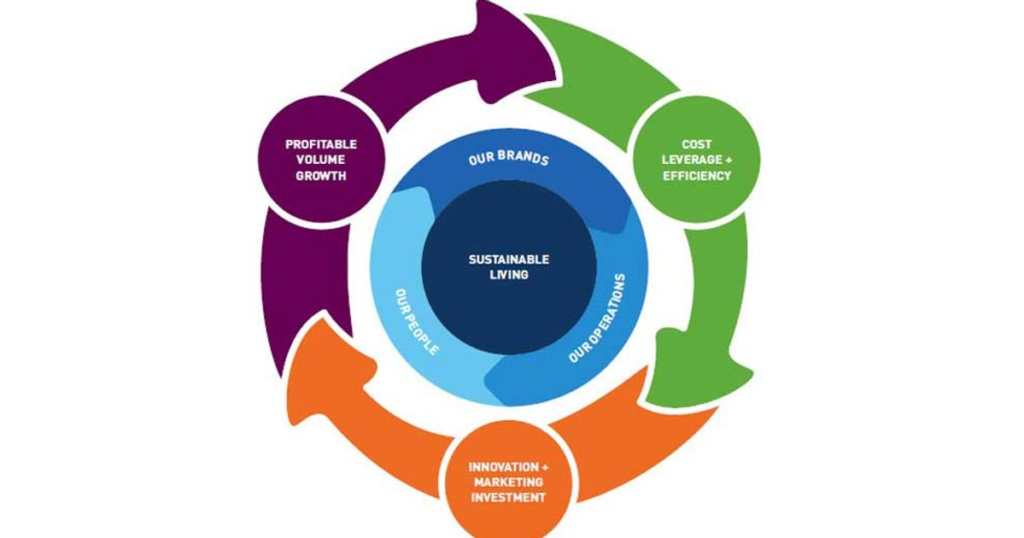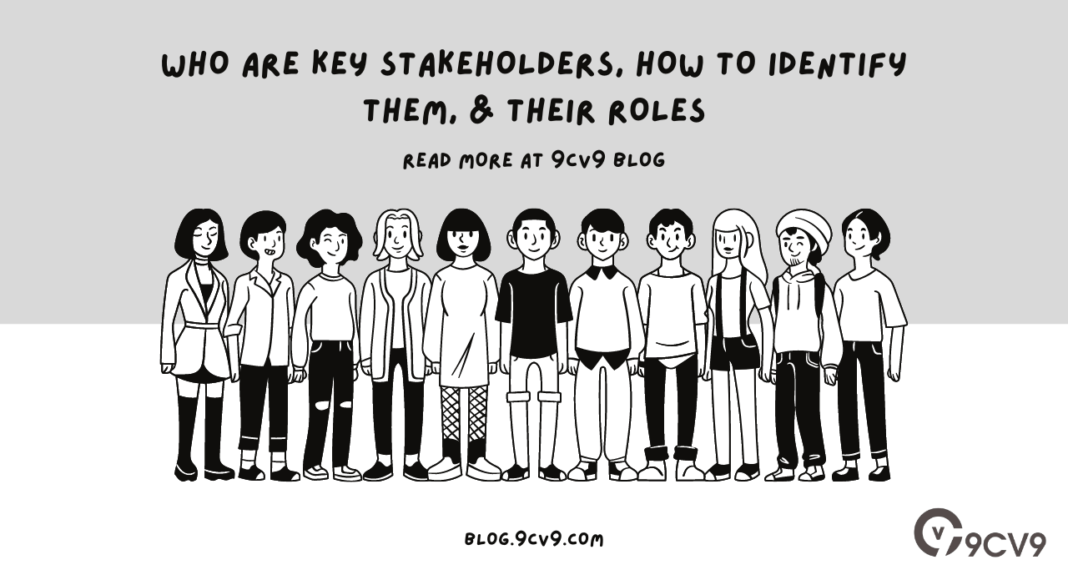Key Takeaways
- Understand the spectrum: From employees to regulatory bodies, grasp the diverse landscape of key stakeholders influencing your organization’s journey.
- Prioritize engagement: Effective stakeholder management involves actively listening, engaging, and fostering collaborative partnerships for mutual benefit.
- Role clarity drives strategy: Identifying and comprehending stakeholder roles empowers strategic decision-making, fostering alignment and value creation.
In the intricate tapestry of business operations and organizational dynamics, few elements are as fundamental and influential as stakeholders.
Whether you’re a budding entrepreneur launching a startup, a seasoned executive navigating the corporate landscape, or a community leader driving societal change, understanding key stakeholders and their roles is paramount for achieving sustainable growth and fostering meaningful impact.
In this comprehensive exploration, we embark on a journey to unravel the essence of key stakeholders, demystify the process of identifying them, and delve into the intricate web of their roles within diverse contexts.
From boardrooms to grassroots initiatives, stakeholders wield considerable influence, shaping decisions, driving strategies, and ultimately determining the trajectory of organizations and projects.
Also, read our top guide on Leadership Titles: The Ultimate Guide to Choosing the Right Title for Your Role to learn more about leadership and stakeholders.
But who exactly are these stakeholders, and why do they hold such sway?
At its core, the concept of stakeholders transcends mere financial interests or hierarchical structures.
It encompasses a diverse array of individuals, groups, or entities, each with a vested interest in the outcomes and activities of an organization or initiative.

From internal stakeholders such as employees and management to external entities like customers, suppliers, regulatory bodies, and community groups, the stakeholder landscape is multifaceted and ever-evolving.
The significance of identifying key stakeholders cannot be overstated.
In a dynamic and interconnected world, organizations must navigate a complex ecosystem of competing interests, expectations, and priorities.
Failure to recognize and engage with the right stakeholders can lead to missed opportunities, strategic missteps, and even reputational damage.
Hence, the ability to conduct thorough stakeholder analysis and discern the influencers, advocates, and detractors is a critical skill for leaders and decision-makers across industries.
Yet, the process of identifying stakeholders is not merely an exercise in listing names or affiliations.
It requires a nuanced understanding of power dynamics, relationships, and contextual nuances.
From stakeholder mapping techniques to sophisticated analysis tools and stakeholder engagement strategies, organizations employ a diverse array of methodologies to identify and prioritize stakeholders effectively.
Once identified, understanding the roles and responsibilities of key stakeholders is paramount.
Whether they serve as internal champions driving organizational change or external partners influencing market dynamics, stakeholders play multifaceted roles that shape business strategies, inform policy decisions, and drive innovation.
By comprehending the unique perspectives, motivations, and expectations of stakeholders, organizations can tailor their approaches, foster collaboration, and mitigate conflicts effectively.
In this blog, we embark on a journey to dissect the intricacies of key stakeholders, offering actionable insights, real-world examples, and best practices for effective stakeholder management.
Drawing from diverse industries, academic research, and practical experiences, we seek to empower readers with the knowledge and tools necessary to navigate the complex landscape of stakeholder engagement.
As we traverse the realms of stakeholder theory, stakeholder identification techniques, and stakeholder roles, our ultimate goal is clear: to equip organizations and individuals with the insights and strategies needed to harness the power of key stakeholders for organizational success.
Whether you’re a business leader striving to foster stakeholder buy-in, a project manager seeking to build collaborative partnerships, or an advocate championing social change, the principles and practices elucidated herein are sure to resonate and inspire action.
Join us as we embark on this illuminating journey into the world of key stakeholders, where every voice matters, and every relationship holds the potential to shape the future.
Together, let us unlock the transformative power of stakeholder engagement and forge a path towards a more inclusive, resilient, and prosperous tomorrow.
Before we venture further into this article, we like to share who we are and what we do.
About 9cv9
9cv9 is a business tech startup based in Singapore and Asia, with a strong presence all over the world.
With over eight years of startup and business experience, and being highly involved in connecting with thousands of companies and startups, the 9cv9 team has listed some important learning points in this overview of Who are Key Stakeholders, How to Identify Them, & Their Roles.
If your company needs recruitment and headhunting services to hire top-quality employees, you can use 9cv9 headhunting and recruitment services to hire top talents and candidates. Find out more here, or send over an email to [email protected].
Or just post 1 free job posting here at 9cv9 Hiring Portal in under 10 minutes.
Who are Key Stakeholders, How to Identify Them, & Their Roles
- Understanding Key Stakeholders
- Identifying Key Stakeholders
- Exploring Stakeholder Roles
- Strategies for Effective Stakeholder Management
- The Evolution of Stakeholder Theory
1. Understanding Key Stakeholders
In the intricate web of organizational dynamics, understanding key stakeholders forms the bedrock of effective decision-making, strategic planning, and stakeholder engagement initiatives.
Let’s delve deeper into the essence of key stakeholders, dissecting their significance and exploring their diverse manifestations across various contexts.
Defining Key Stakeholders: Who Are They?
- Definition: Key stakeholders encompass individuals, groups, or entities with a vested interest in the outcomes, activities, or decisions of an organization or initiative.
- Characteristics:
- Stakeholders can be internal or external to the organization.
- They possess varying degrees of influence, power, and interest in the organization’s affairs.
- Stakeholders may include employees, investors, customers, suppliers, regulatory bodies, community groups, and more.

Types of Stakeholders: Internal vs. External
- Internal Stakeholders:
- Employees: The workforce forms a crucial internal stakeholder group, contributing to the organization’s operations, culture, and success.
- Example: Employees of a tech company may advocate for workplace diversity initiatives, influencing organizational policies and practices.
- Management: Executives, managers, and leadership teams hold significant influence over strategic direction, resource allocation, and decision-making processes.
- Example: The CEO of a multinational corporation shapes corporate strategy, guiding the organization’s growth and expansion efforts.
- Shareholders: Individuals or entities owning shares in a company possess a financial stake in its performance and profitability.
- Example: Institutional investors may exert pressure on a publicly-traded company to prioritize environmental sustainability initiatives to enhance long-term value.
- Employees: The workforce forms a crucial internal stakeholder group, contributing to the organization’s operations, culture, and success.
- External Stakeholders:
- Customers: External stakeholders include individuals or entities consuming products or services offered by the organization.
- Example: Customer feedback drives product development and marketing strategies, shaping the customer experience and brand reputation.
- Suppliers: External partners providing goods or services crucial to the organization’s operations.
- Example: Automotive manufacturers rely on a network of suppliers for components, materials, and logistics services to ensure smooth production processes.
- Government Agencies: Regulatory bodies, policymakers, and government entities wield influence over industries through legislation, regulations, and enforcement actions.
- Example: Environmental agencies may impose emissions standards on manufacturing facilities, prompting companies to invest in sustainable technologies.
- Community Groups: Non-profit organizations, advocacy groups, and local communities often have a stake in corporate activities impacting social, environmental, or economic well-being.
- Example: Community activists may rally against a proposed construction project, citing concerns about environmental impact and community displacement.
- Customers: External stakeholders include individuals or entities consuming products or services offered by the organization.
Significance of Identifying Key Stakeholders
- Strategic Alignment: Identifying key stakeholders enables organizations to align their goals, priorities, and initiatives with stakeholder interests, fostering mutual benefit and long-term sustainability.
- Risk Mitigation: Understanding stakeholder expectations and concerns allows organizations to anticipate potential risks, proactively address issues, and mitigate adverse impacts on stakeholders and the business.
- Enhanced Decision-making: By incorporating diverse stakeholder perspectives into decision-making processes, organizations can make more informed, ethical, and socially responsible choices that resonate with key stakeholders.
- Stakeholder Engagement: Effective stakeholder identification lays the foundation for meaningful engagement strategies, fostering trust, transparency, and collaboration between organizations and their stakeholders.
In essence, the process of understanding key stakeholders transcends mere recognition of their presence; it entails a holistic appreciation of their interests, aspirations, and influence within the organizational ecosystem.
By embracing stakeholder-centric approaches, organizations can navigate complexities, unlock opportunities, and cultivate enduring partnerships that drive shared value and sustainable growth.
2. Identifying Key Stakeholders
Identifying key stakeholders is a crucial step in effective stakeholder management and organizational strategy.
By comprehensively mapping out individuals, groups, and entities with a vested interest in the organization’s activities, leaders can proactively engage with stakeholders, address concerns, and drive positive outcomes.
Let’s delve into various methodologies and techniques for identifying key stakeholders, accompanied by relevant examples from different industries.
Methods and Techniques for Stakeholder Identification

- Stakeholder Mapping:
- Definition: Stakeholder mapping involves visually representing the relationships, interests, and influence of key stakeholders in relation to the organization.
- Process:
- Identify Stakeholder Categories: Segment stakeholders into groups based on their relationship with the organization (e.g., internal vs. external) and their level of influence or interest.
- Analyze Stakeholder Attributes: Assess stakeholder attributes such as power, legitimacy, urgency, proximity, and salience to prioritize stakeholders and tailor engagement strategies.
- Map Stakeholder Relationships: Plot stakeholders on a visual map, indicating their relationships with the organization and each other, facilitating a holistic understanding of the stakeholder landscape.
- Example:
- A multinational corporation conducting stakeholder mapping may categorize stakeholders into groups such as employees, shareholders, customers, suppliers, regulatory bodies, and community organizations. By analyzing the power and interest of each stakeholder group, the organization can identify key influencers and devise targeted engagement strategies.
- Stakeholder Analysis Tools:
- Definition: Stakeholder analysis tools provide frameworks, matrices, and templates for systematically assessing stakeholder attributes, interests, and relationships.
- Popular Tools:
- Power-Interest Grid: Classifies stakeholders based on their level of power and interest in the organization, guiding prioritization and engagement efforts.
- Salience Model: Considers stakeholder attributes such as power, legitimacy, and urgency to determine their significance and influence on organizational outcomes.
- Influence-Interest Matrix: Evaluates stakeholders based on their ability to influence decisions and their level of interest in the organization’s activities.
- Example:
- A construction company using the Power-Interest Grid may identify government agencies as high-power stakeholders due to their regulatory authority, while local communities may have high interest but lower power. This analysis guides the company in tailoring engagement strategies to address the concerns of influential stakeholders effectively.
- Surveys and Interviews:
- Definition: Surveys and interviews enable organizations to gather insights directly from stakeholders regarding their expectations, preferences, and concerns.
- Approach:
- Design Surveys and Interview Protocols: Develop structured surveys or interview guides to elicit feedback from stakeholders on relevant topics such as organizational priorities, performance, and impact.
- Engage Stakeholders: Distribute surveys electronically or conduct interviews with key stakeholders, ensuring confidentiality, transparency, and inclusivity in the data collection process.
- Analyze Responses: Synthesize survey responses or interview transcripts to identify common themes, priorities, and areas for improvement, informing stakeholder engagement strategies.
- Example:
- A healthcare organization seeking to identify key stakeholders may administer surveys to patients, healthcare providers, insurers, and regulatory agencies to understand their perspectives on healthcare delivery, quality of care, and policy priorities. Insights gleaned from these surveys inform strategic decisions and quality improvement initiatives.
Examples of Effective Stakeholder Identification
- Example 1: Sustainable Fashion Brand:
- Scenario: A sustainable fashion brand aims to identify key stakeholders to enhance transparency and accountability in its supply chain.
- Approach: The company conducts stakeholder mapping exercises, categorizing stakeholders into groups such as suppliers, workers’ unions, environmental NGOs, and consumers. Stakeholder analysis tools such as the Salience Model help prioritize stakeholders based on their influence and proximity to the organization.
- Outcome: By engaging with key stakeholders through targeted communication, collaboration, and stakeholder dialogue initiatives, the fashion brand strengthens relationships, addresses sustainability concerns, and fosters trust among stakeholders.
- Example 2: Technology Startup:
- Scenario: A technology startup seeks to identify key stakeholders to support its product development and market expansion efforts.
- Approach: The startup employs surveys and interviews to gather feedback from customers, investors, industry experts, and regulatory agencies. Stakeholder analysis tools such as the Influence-Interest Matrix help prioritize stakeholders based on their potential impact on the startup’s success.
- Outcome: By incorporating stakeholder input into product design, marketing strategies, and regulatory compliance efforts, the startup enhances its market competitiveness, fosters investor confidence, and mitigates risks associated with stakeholder opposition.
In essence, effective stakeholder identification empowers organizations to navigate complexities, anticipate challenges, and leverage opportunities to drive positive outcomes.
By embracing diverse methodologies and tools, organizations can gain valuable insights into stakeholder interests, concerns, and expectations, laying the foundation for meaningful engagement and collaborative partnerships.
3. Exploring Stakeholder Roles
Understanding the roles and responsibilities of key stakeholders is essential for effective stakeholder management and organizational decision-making.
Stakeholders play diverse and influential roles in shaping business strategies, driving innovation, and impacting societal outcomes.
Let’s delve into the multifaceted roles of stakeholders across various contexts, accompanied by relevant examples from different industries.
Roles and Responsibilities of Internal Stakeholders
- Employees:
- Contributors to Organizational Success: Employees contribute their skills, knowledge, and expertise to organizational operations, driving innovation, productivity, and performance.
- Ambassadors of Organizational Culture: Employees embody the values, mission, and culture of the organization, serving as brand ambassadors and fostering a positive workplace environment.
- Examples:
- In a tech company, software developers play a crucial role in product development, coding, and testing software solutions, driving technological advancement and market competitiveness.
- HR professionals champion diversity and inclusion initiatives, recruitment efforts, and employee development programs, enhancing organizational culture and employee engagement.
- Management:
- Strategic Decision-makers: Management teams formulate and execute strategic plans, allocating resources, setting goals, and guiding the organization’s direction.
- Leadership and Vision: Executives provide leadership, vision, and direction to inspire and motivate employees, stakeholders, and shareholders.
- Examples:
- The CEO of a multinational corporation sets the strategic vision, oversees corporate governance, and represents the company’s interests to stakeholders, driving growth and profitability.
- Middle managers coordinate day-to-day operations, supervise teams, and implement strategic initiatives, ensuring alignment with organizational goals and objectives.
- Shareholders:
- Financial Stakeholders: Shareholders invest capital in the organization in exchange for ownership stakes, expecting returns on their investments in the form of dividends, capital appreciation, or other financial benefits.
- Governance and Oversight: Shareholders exercise voting rights, elect board members, and provide oversight to safeguard their interests and ensure corporate accountability.
- Examples:
- Institutional investors, such as pension funds and asset management firms, hold significant equity stakes in publicly-traded companies, influencing corporate governance, executive compensation, and strategic decisions.
- Individual shareholders may advocate for environmental, social, and governance (ESG) initiatives, urging companies to prioritize sustainability, ethical practices, and long-term value creation.
Roles and Responsibilities of External Stakeholders
- Customers:
- Market Demand Drivers: Customers drive demand for products and services, shaping market trends, preferences, and purchasing behavior.
- Feedback Providers: Customers provide valuable feedback, insights, and reviews that inform product development, marketing strategies, and customer service improvements.
- Examples:
- In the retail industry, consumer preferences for sustainable and ethically sourced products influence purchasing decisions, prompting companies to adopt responsible sourcing practices and eco-friendly packaging.
- Customer feedback on user experience and product functionality drives iterative improvements in software development, enhancing usability, performance, and customer satisfaction.
- Suppliers:
- Strategic Partnerships: Suppliers provide goods, materials, or services essential to the organization’s operations, fostering strategic partnerships and supply chain resilience.
- Quality Assurance and Compliance: Suppliers adhere to quality standards, regulatory requirements, and contractual agreements to ensure product integrity and compliance.
- Examples:
- Automotive manufacturers rely on a network of suppliers for components, materials, and logistics services to ensure just-in-time inventory management, cost efficiency, and production scalability.
- Pharmaceutical companies partner with contract manufacturing organizations (CMOs) to produce active pharmaceutical ingredients (APIs) and drug formulations, ensuring compliance with Good Manufacturing Practice (GMP) standards and regulatory approvals.
- Government Agencies:
- Regulatory Compliance: Government agencies establish and enforce laws, regulations, and standards to protect public health, safety, and welfare, requiring organizations to comply with legal requirements and industry regulations.
- Policy Advocacy: Government agencies advocate for policies, initiatives, and programs that promote economic development, environmental sustainability, and social welfare.
- Examples:
- Environmental Protection Agency (EPA) regulations mandate emissions standards for industrial facilities, driving companies to invest in pollution control technologies and sustainable practices to mitigate environmental impact.
- Food and Drug Administration (FDA) oversight ensures pharmaceutical companies adhere to stringent safety, efficacy, and quality standards in drug development, manufacturing, and distribution, safeguarding public health and consumer confidence.
- Community Groups:
- Local Impact and Engagement: Community groups represent the interests, concerns, and aspirations of local residents, businesses, and stakeholders, advocating for social, environmental, and economic initiatives.
- Stakeholder Consultation: Community groups participate in stakeholder consultations, public hearings, and community engagement activities to voice community perspectives, preferences, and priorities.
- Examples:
- Environmental advocacy groups campaign for renewable energy initiatives, conservation efforts, and climate change mitigation policies, mobilizing public support and influencing government decision-making.
- Neighborhood associations collaborate with real estate developers, city planners, and local governments to shape urban development projects, infrastructure improvements, and community revitalization efforts.
In summary, stakeholders play diverse and critical roles in shaping organizational strategies, driving innovation, and influencing societal outcomes.
By understanding the roles and responsibilities of key stakeholders, organizations can foster collaborative partnerships, build trust, and achieve shared goals that benefit stakeholders and society at large.
4. Strategies for Effective Stakeholder Management
Effective stakeholder management is essential for building positive relationships, fostering collaboration, and achieving organizational goals.
By implementing strategic approaches to engage and communicate with stakeholders, organizations can enhance trust, mitigate risks, and drive sustainable success.
Let’s explore various strategies for effective stakeholder management, accompanied by relevant examples from different industries.
Building Positive Relationships with Key Stakeholders
- Transparent Communication:
- Openness and Honesty: Foster transparent communication channels to keep stakeholders informed about organizational activities, decisions, and performance.
- Active Listening: Listen attentively to stakeholder feedback, concerns, and perspectives, demonstrating empathy and responsiveness to their needs.
- Example: A pharmaceutical company communicates openly with patients, healthcare providers, and regulatory agencies about drug development processes, safety profiles, and clinical trial outcomes, building trust and confidence in its products and practices.
- Stakeholder Engagement Initiatives:
- Regular Dialogues: Organize stakeholder forums, workshops, and focus groups to facilitate meaningful discussions, exchange ideas, and gather input on key issues.
- Collaborative Decision-making: Involve stakeholders in decision-making processes, seeking consensus and co-creating solutions that align with shared interests.
- Example: A renewable energy company collaborates with local communities, environmental NGOs, and government agencies to solicit feedback on wind farm development projects, addressing concerns about visual impact, wildlife preservation, and community benefits.
Communication Strategies to Engage Stakeholders
- Tailored Messaging:
- Audience Segmentation: Customize communication materials and messages to resonate with the diverse needs, interests, and preferences of different stakeholder groups.
- Clear and Concise Messaging: Use plain language and visuals to convey complex information effectively, ensuring clarity, comprehension, and engagement.
- Example: A technology company tailors marketing campaigns to target specific customer segments, highlighting product features, benefits, and use cases that appeal to their unique needs and preferences.
- Multi-channel Communication:
- Omni-channel Approach: Utilize diverse communication channels such as email, social media, websites, and in-person meetings to reach stakeholders through their preferred channels.
- Interactive Platforms: Leverage interactive tools and platforms such as webinars, online forums, and mobile apps to facilitate two-way communication and engagement.
- Example: A retail brand employs an omni-channel marketing strategy, seamlessly integrating online and offline channels to engage customers through e-commerce platforms, social media campaigns, and personalized in-store experiences.
Conflict Resolution Techniques
- Conflict Resolution Frameworks:
- Collaborative Problem-solving: Encourage stakeholders to collaborate in identifying common goals, exploring mutually beneficial solutions, and resolving conflicts amicably.
- Mediation and Arbitration: Engage neutral third parties or mediators to facilitate constructive dialogue, negotiation, and resolution of disputes.
- Example: A construction company employs a collaborative approach to resolve conflicts with local communities impacted by infrastructure projects, facilitating community consultations, addressing concerns, and reaching consensus on mitigation measures.
- Negotiation Strategies:
- Win-Win Solutions: Strive to negotiate outcomes that meet the interests and needs of all parties involved, fostering long-term relationships and shared value creation.
- Compromise and Flexibility: Be willing to compromise and adapt positions to accommodate diverse perspectives, priorities, and constraints.
- Example: A labor union negotiates with management to achieve a collective bargaining agreement that balances the interests of workers, employers, and shareholders, addressing wage demands, benefits, and working conditions.
Continuous Monitoring and Evaluation of Stakeholder Engagement
- Feedback Mechanisms:
- Surveys and Feedback Forms: Solicit stakeholder feedback through surveys, feedback forms, and satisfaction ratings to assess the effectiveness of engagement efforts.
- Key Performance Indicators (KPIs): Establish measurable KPIs to track stakeholder engagement metrics such as participation rates, sentiment analysis, and stakeholder satisfaction scores.
- Example: A non-profit organization conducts annual stakeholder surveys to evaluate donor satisfaction, volunteer engagement, and program impact, informing strategic planning and performance improvement initiatives.
- Iterative Improvement:
- Feedback Incorporation: Actively incorporate stakeholder feedback and suggestions into continuous improvement processes, adjusting strategies, policies, and practices accordingly.
- Adaptive Management: Embrace a flexible and adaptive approach to stakeholder management, responding proactively to changing stakeholder dynamics, expectations, and emerging issues.
- Example: An educational institution implements an agile feedback loop system, gathering input from students, faculty, and parents to refine curriculum designs, teaching methodologies, and student support services.
5. The Evolution of Stakeholder Theory
Stakeholder theory, originating in the realm of management and corporate governance, has undergone significant evolution over the decades, reflecting shifting paradigms, societal expectations, and organizational dynamics.
From its nascent stages to contemporary perspectives, the evolution of stakeholder theory offers valuable insights into the roles, responsibilities, and interactions of stakeholders within organizational ecosystems.
Let’s explore the key milestones and developments in the evolution of stakeholder theory, accompanied by relevant examples and implications for practice.
Origins of Stakeholder Theory
- Early Conceptualizations:
- 1960s and 1970s: The roots of stakeholder theory can be traced back to seminal works by scholars such as R. Edward Freeman and Ian Mitroff, who introduced the concept of stakeholders as individuals or groups affected by or affecting the actions of an organization.
- Focus on Shareholder Primacy: Traditional management theories emphasized shareholder primacy, viewing shareholders as the primary stakeholders entitled to maximize financial returns.
- Example: Milton Friedman’s advocacy of shareholder primacy in his seminal article “The Social Responsibility of Business is to Increase its Profits” underscored the prevailing view of corporations’ sole responsibility to shareholders.

Development of Stakeholder Theory
- Expansion of Stakeholder Concept:
- 1980s and 1990s: Stakeholder theory expanded to recognize the interests and concerns of diverse stakeholder groups beyond shareholders, including employees, customers, suppliers, communities, and the environment.
- Shift to Stakeholder Management: Scholars advocated for a stakeholder management approach, emphasizing the importance of actively engaging with and balancing the interests of multiple stakeholders to achieve long-term organizational sustainability.
- Example: Freeman’s seminal book “Strategic Management: A Stakeholder Approach” introduced the concept of stakeholder management as a strategic imperative for organizations to navigate complex stakeholder relationships and create shared value.
Contemporary Perspectives on Stakeholder Theory
- Integration of Sustainability and CSR:
- 21st Century: Stakeholder theory evolved to incorporate sustainability principles, corporate social responsibility (CSR), and environmental, social, and governance (ESG) considerations into organizational decision-making.
- Triple Bottom Line Framework: The triple bottom line framework, encompassing economic, social, and environmental dimensions, emerged as a guiding principle for organizations to assess and report their impact on stakeholders and society.
- Example: Unilever’s Sustainable Living Plan exemplifies the integration of stakeholder theory with sustainability practices, as the company commits to reducing environmental footprint, enhancing social impact, and delivering sustainable growth.
- Stakeholder Engagement and Co-creation:
- Emergence of Stakeholder Engagement Platforms: Organizations leverage technology and digital platforms to facilitate stakeholder engagement, collaboration, and co-creation of value.
- Co-creation of Value: Stakeholder theory emphasizes the co-creation of value through collaborative partnerships with stakeholders, recognizing their role as active contributors to organizational success.
- Example: LEGO’s Ideas platform enables customers to submit and vote on new product ideas, fostering a participatory design process and strengthening brand loyalty through co-creation with passionate fans and enthusiasts.

Implications for Practice
- Strategic Stakeholder Management:
- Holistic Approach: Organizations adopt a holistic approach to stakeholder management, integrating stakeholder perspectives into strategic planning, decision-making, and performance evaluation.
- Long-term Value Creation: Stakeholder theory advocates for a long-term perspective on value creation, emphasizing the importance of balancing short-term financial objectives with the interests of diverse stakeholders.
- Example: Patagonia’s commitment to environmental sustainability and social responsibility resonates with stakeholders, driving brand loyalty, employee engagement, and customer advocacy while delivering long-term financial performance.
- Corporate Governance and Accountability:
- Board Oversight: Corporate boards play a pivotal role in overseeing stakeholder engagement, risk management, and sustainability practices, ensuring alignment with organizational values and stakeholder expectations.
- Transparency and Disclosure: Organizations prioritize transparency and disclosure of relevant information to stakeholders, fostering trust, accountability, and stakeholder confidence.
- Example: The Governance & Accountability Institute reports that over 90% of S&P 500 companies now publish sustainability reports, demonstrating a growing commitment to transparency and stakeholder accountability.
Future Directions in Stakeholder Theory
- Integration of Emerging Trends:
- Technology and Innovation: Stakeholder theory adapts to emerging trends such as digitalization, artificial intelligence, and blockchain, exploring their implications for stakeholder engagement, data privacy, and ethical decision-making.
- Globalization and Diversity: Increasing globalization and cultural diversity pose challenges and opportunities for stakeholder theory to address cross-cultural communication, inclusivity, and equitable stakeholder representation.
- Example: Airbnb’s stakeholder engagement strategies reflect its global footprint, as the company navigates regulatory challenges, cultural sensitivities, and community impacts in diverse markets worldwide.
- Continued Evolution and Adaptation:
- Dynamic Environment: Stakeholder theory evolves in response to changing societal expectations, regulatory frameworks, and technological advancements, necessitating ongoing research, dialogue, and adaptation.
- Interdisciplinary Perspectives: Stakeholder theory draws insights from diverse disciplines such as sociology, psychology, economics, and ecology, enriching its theoretical foundations and practical applications.
- Example: The United Nations Sustainable Development Goals (SDGs) serve as a rallying point for stakeholders worldwide, driving collaborative action and stakeholder engagement to address global challenges such as poverty, inequality, and climate change.
The evolution of stakeholder theory reflects a paradigm shift from shareholder primacy to stakeholder management, sustainability, and value creation.
As organizations embrace stakeholder-centric approaches, they recognize the interconnectedness of stakeholders and the imperative of balancing diverse interests to achieve long-term success and societal impact.
By integrating stakeholder theory into strategic decision-making, organizations can navigate complexities, build resilience, and create shared value for stakeholders and society at large.
Conclusion
In the dynamic landscape of organizational management and stakeholder engagement, the significance of understanding key stakeholders, identifying them effectively, and comprehending their diverse roles cannot be overstated.
Through this comprehensive exploration, we’ve delved into the intricacies of key stakeholders, offering actionable insights, practical strategies, and real-world examples to guide organizations in navigating the complexities of stakeholder relationships.
From defining key stakeholders to exploring stakeholder roles and responsibilities, our journey has illuminated the multifaceted nature of stakeholder engagement and its profound impact on organizational success.
We’ve dissected methodologies for identifying stakeholders, ranging from stakeholder mapping techniques to stakeholder analysis tools and stakeholder engagement initiatives, empowering leaders to navigate stakeholder ecosystems with confidence and clarity.
Furthermore, we’ve examined the evolving landscape of stakeholder theory, tracing its origins, development, and contemporary perspectives.
From its roots in shareholder primacy to its transformation into stakeholder management and sustainability frameworks, stakeholder theory continues to shape organizational strategies, corporate governance practices, and societal expectations in an ever-changing world.
As we conclude our exploration of key stakeholders, it’s evident that effective stakeholder management is not merely a matter of compliance or corporate social responsibility; it’s a strategic imperative for organizational resilience, innovation, and long-term value creation.
By embracing stakeholder-centric approaches, organizations can foster trust, collaboration, and shared prosperity among stakeholders, driving sustainable growth and societal impact.
In this era of rapid technological advancement, globalization, and societal change, the ability to navigate the complexities of key stakeholders is more crucial than ever.
As organizations confront unprecedented challenges such as climate change, social inequality, and digital disruption, stakeholder engagement emerges as a linchpin for resilience, adaptability, and ethical leadership.
Moving forward, we encourage organizations to adopt a proactive stance towards stakeholder engagement, integrating stakeholder perspectives into strategic decision-making, performance evaluation, and risk management processes.
By prioritizing transparency, inclusivity, and accountability, organizations can cultivate enduring partnerships, mitigate risks, and seize opportunities for innovation and growth in an interconnected world.
In closing, the journey of understanding key stakeholders, identifying them effectively, and comprehending their roles is an ongoing endeavor—one that requires dedication, empathy, and continuous learning.
As stewards of organizational success and societal impact, let us embrace the transformative power of stakeholder engagement, forging a path towards a more inclusive, resilient, and sustainable future for all stakeholders involved.
If your company needs HR, hiring, or corporate services, you can use 9cv9 hiring and recruitment services. Book a consultation slot here, or send over an email to [email protected].
If you find this article useful, why not share it with your hiring manager and C-level suite friends and also leave a nice comment below?
We, at the 9cv9 Research Team, strive to bring the latest and most meaningful data, guides, and statistics to your doorstep.
To get access to top-quality guides, click over to 9cv9 Blog.
People Also Ask
What is the significance of identifying key stakeholders?
Understanding key stakeholders helps organizations anticipate concerns, align strategies, and foster collaboration for sustainable success.
How can I identify key stakeholders?
You can identify key stakeholders through stakeholder mapping, analysis tools, surveys, interviews, and consultation with relevant parties.
Who are considered internal stakeholders?
Internal stakeholders include employees, management, and shareholders who have a direct impact on the organization’s operations and decisions.
Who are considered external stakeholders?
External stakeholders encompass customers, suppliers, government agencies, community groups, and other entities affected by or affecting the organization.
How do stakeholders influence organizational decisions?
Stakeholders influence organizational decisions through their interests, concerns, power dynamics, and ability to affect the organization’s outcomes.
What are the roles of employees as stakeholders?
Employees contribute to organizational success through their skills, knowledge, and dedication, while also advocating for workplace well-being and organizational values.
What roles do management play as stakeholders?
Management sets strategic direction, oversees operations, and represents the organization’s interests, balancing stakeholder needs with business objectives.
What roles do shareholders play as stakeholders?
Shareholders provide capital, exercise governance rights, and expect returns on their investments, influencing organizational decisions and performance.
How do customers contribute as stakeholders?
Customers drive demand, provide feedback, and shape market trends, influencing product development, marketing strategies, and brand reputation.
What roles do suppliers play as stakeholders?
Suppliers provide essential goods or services, impacting product quality, supply chain efficiency, and organizational performance.
What roles do government agencies play as stakeholders?
Government agencies regulate industries, enforce laws, and advocate for policies that affect organizational operations, compliance, and public welfare.
How do community groups contribute as stakeholders?
Community groups represent local interests, advocate for social, environmental, and economic initiatives, and influence organizational decisions affecting communities.
What are the benefits of stakeholder engagement?
Stakeholder engagement fosters trust, transparency, and collaboration, leading to improved decision-making, risk mitigation, and long-term organizational success.
How can organizations manage conflicts with stakeholders?
Organizations can manage conflicts through dialogue, negotiation, mediation, and compromise, seeking mutually beneficial solutions to address stakeholder concerns.
How does stakeholder theory influence corporate governance?
Stakeholder theory promotes a broader view of corporate governance, emphasizing accountability, transparency, and stakeholder engagement in decision-making processes.
What are the implications of stakeholder theory for business strategy?
Stakeholder theory encourages organizations to align business strategies with stakeholder interests, fostering long-term value creation, and societal impact.
How can organizations integrate sustainability into stakeholder management?
Organizations can integrate sustainability by considering environmental, social, and governance (ESG) factors in stakeholder engagement, decision-making, and reporting.
What role does stakeholder engagement play in risk management?
Stakeholder engagement helps organizations identify, assess, and mitigate risks by soliciting input, building relationships, and addressing stakeholder concerns proactively.
How does stakeholder engagement contribute to innovation?
Stakeholder engagement fosters innovation by incorporating diverse perspectives, insights, and feedback into product development, process improvement, and business model innovation.































![Writing A Good CV [6 Tips To Improve Your CV] 6 Tips To Improve Your CV](https://blog.9cv9.com/wp-content/uploads/2020/06/2020-06-02-2-100x70.png)


